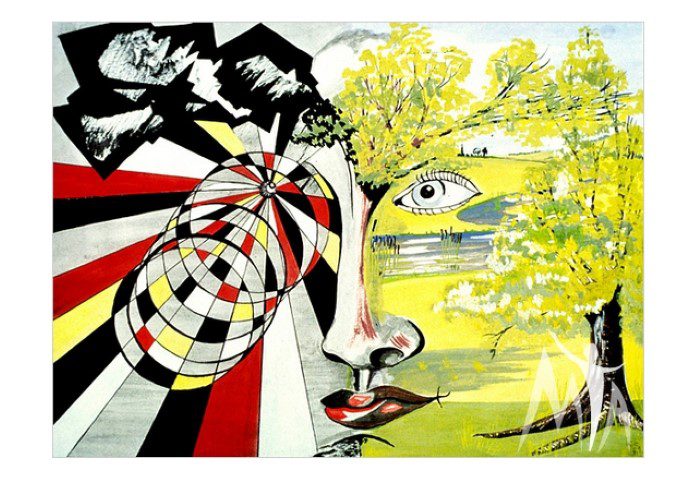JH McAuley
London, United Kingdom

More than simply representing their visual environment, artists depict their visual experiences. Their work is invested with a personal emotional context. In some cases, the subject becomes the emotion itself, as conveyed in abstract colors and patterns or invoked by the expression on a human face; a popular example is of course Munch’s Der Schrei der Natur (“The Scream”).
The personal context of art is perhaps no better illustrated than in the situation where the artist’s subject is seen but does not actually exist—a hallucination. Migraineurs often vividly describe the visual aurae that precede or accompany episodes of headache.1 A variety of images, called scotomata, play across the visual field, sometimes jagged lines called fortification spectra due to their similarity to the crenellations of a medieval battlement, sometimes kaleidoscopes of whirling shapes and colors masking or superimposed upon the real image of the environment. Yet other scotomata take the form of monochrome opaque smears, often with shimmering margins. A large part of the visual field may convey an impression of motion so that the image is distorted as if looking through a streaming waterfall. The “show” is typically gradual in evolution, moving slowly across the visual field from periphery to center or vice versa over a matter of minutes. In many respects this is a blessing for the sufferer; there is often time to take migraine attack medication before the headache and vomiting start and time to pull over safely if driving a motor vehicle.
Those with artistic leanings may naturally wish to convey their migrainous experience visually as well as orally, and there are numerous examples in the fields of art and medicine of visual representations of scotomata.2 Perhaps, as well as educating others, such artists experience a catharsis of sorts, drawing out their experience onto canvas.
The figure below illustrates many different features of migraine and migraine aura. A kaleidoscope of geometric patterns of colors appears to bore into one eye, conveying the quality and unilaterality of the headache, as well as the visual experience. At the same time, monochrome jagged lines arc across part of the visual field. The other hemifield is relatively spared but is nevertheless cast in a vivid bright bloom conveying the photophobic experience that characteristically accompanies migraine.
The pathophysiologic basis of the aura is thought to relate to a phenomenon known as the spreading depression of Leão.3 A wave of depolarization passes across the neocortex at a rate of around 2-5 mm/minute, followed by a wave of hyperpolarization. In parallel with this is vasoconstriction of the cortical arterioles followed by vasodilatation. The relative simplicity of the geometric hallucinations in migraine reflect depolarizations of units of the primary visual cortex, where individual neurones and collections of neurones normally fire in response to oriented bars, to motion in a certain direction, and to color. It is in the association visual cortex, lying more anteriorly across the convexity of the hemisphere and less typically involved in migraine aura, where these disparate strands of visual information are joined together to form a complete image.
The simplicity of migrainous scotomata characterize their appearance in the works of artists through the centuries, ranging from the vivid patterns of the visions of Hildegard of Bingen in her work Scivias (1151-1152) to the “Strip!” paintings of Sarah Raphael (1998). Other artists have used a more abstract interpretation of the visual distortions of migraine to inspire their work; well-known examples are Lewis Carroll’s distorted children’s illustrations in Alice in Wonderland (1864) and the distorted melting clocks of Salvadore Dali’s The Persistence of Memory (1931), the result of a cheese-induced migraine aura. The geometric patterns are so archetypal that they have also been mooted as the possibly subconscious inspiration for schools of modern art, including the pre-surrealist style founded by Giorgio de Chirico and even the cubist works of Pablo Picasso.
Whether inspirations for artistic movements or simply the illustrations of amateurs, many examples of which are held in the collection of the Migraine Action charity (which can be reached at [email protected]), it is clear that representations of visual aurae are as individual as their sufferers, conceived from the myriad manifestations of spreading depression across the visual cortex and focused by the lens of emotion and personal experience through which artists create their work.
References
- Gowers WR. Subjective visual sensations. Trans Ophthalmol Soc UK. 1895;15:1-38.
- Fuller GN, Gale MV. Migraine aura as artistic inspiration. BMJ. 1988;297:1670-1672.
- Leão AAP. Spreading depression of activity in the cerebral cortex. J Neurophysiol. 1944;7:359-390.
JH MCAULEY, MA, MD, FRCP, qualified in 1989 at Cambridge University and afterward undertook specialist training in Neurology at the Royal London Hospital and the National Hospital, Queen Square, where in 1996 he was awarded the Ralph Noble Prize for his MD thesis on the rhythmic nature of central motor control and its derangement in neurological disease. He took up his Consultant post in 2001 and was subsequently elected FRCP in 2004. His specialist interests are in Parkinson’s disease, tremor and therapeutic neurostimulation for movement disorders, epilepsy and chronic pain. He runs an electrophysiological research laboratory where he investigates the pathophysiology of movement disorders.
Highlighted in Frontispiece Fall 2015 – Volume 7, Issue 4

Leave a Reply